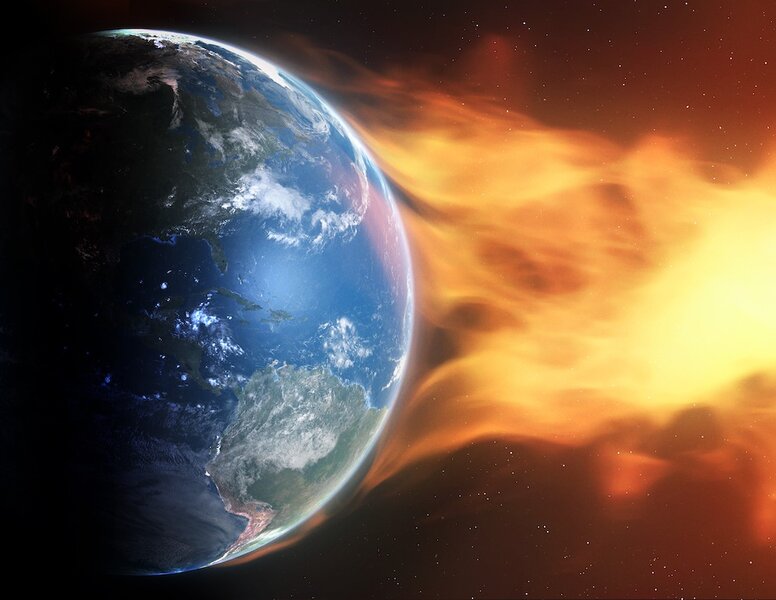Create a free profile to get unlimited access to exclusive videos, sweepstakes, and more!
Could a solar flare destroy humanity, like in 'Finch'? The Science Behind the Fiction
It would be bad for humanity and for dogs, so let's hope not!

If you have to live through a post-apocalyptic event, we can think of worse companions than a friendly robot, a dog, and Tom Hanks. Finch, the latest science fiction action film from Apple TV+, follows Finch Weinberg (Hanks) a survivor of a massive solar flare that decimated society.
**Minor spoilers for Finch below**
When the movie begins, ten years have passed since the flare. The ozone layer is in shambles, and surface temperatures reach 150 degrees Fahrenheit (65 Celsius). The Earth, in short, is not a fun place to live any longer. Finch is suffering from an undisclosed disease which will soon claim his life and he's racing against the clock — and the environment's sucker punches — to develop an intelligent robot and find a safe place, for his dog to live out the rest of its days after he's gone.
In the best interests of all of our dogs, it might benefit us to understand what might really happen if we were blasted by a catastrophic solar flare, in order that we might be better prepared.
WHAT IS A SOLAR FLARE?
The Sun operates on a solar cycle which lasts roughly 11 years from start to finish. During that time, the poles of the Sun's magnetic field flip. As the Sun makes its way along this cycle, it goes through periods of calm and periods of increased activity as the cycle reaches solar maximum.
That activity can be observed through the appearance of sunspots and huge bursts of radiation erupting from its surface. The latter event is known as a solar flare. These are massive flashes of light, photons from the sun being violently released over the course of minutes or hours.
Flares come in a handful of types ranging from A-class (the smallest flares) to X-class, the truly incredible bursts. A flare is classified using the relevant letter followed by a number. An A2 flare, for instance, is twice as powerful as an A1. Each letter class represents a ten-fold increase until we get to X. While there is no letter classification above X, X-class flares can be much more powerful than X10.
In 2003, a flare was measured at X28 but was likely even more powerful, the sensors became overloaded under the explosive energy being measured. It was, quite literally, off the charts. Solar flares are mostly harmless and don't pose much of a threat to humans on the surface of the Earth.
What could cause some problems, however, are coronal mass ejections (CMEs) which are sometimes conflated with solar flares in popular parlance. This might be due in part to them often occurring together. CMEs are a shotgun blast of magnetized plasma particles travelling more than a million miles an hour, outward from the surface of the sun. Through a telescope, they appear as fans of solar material rising from the surface like a whip before flinging themselves into the cosmos.
A CME aimed at Earth can take a few days to cross the distance before impacting the atmosphere, and the ensuing collision, if it's powerful enough, could have a measurable impact on our way of life.
A BIG BLAST
In September of 1859 a solar storm known as the Carrington Event — named for astronomer Richard Carrington who observed the corresponding solar flare the day before — struck Earth causing widespread technological havoc, even considering the comparatively primitive technology of the time. The magnetic effects were so substantial the aurora, normally only seen at polar latitudes, could be seen in the tropics.
Electricity from the storm flowed through the electrical lines of telegraphs, overloading the circuits, starting fires around the world and shocking nearby workers. The global lines of communication were disrupted until the magnetic storm trickled out hours later.
Interestingly, some telegraph operators reported being able to send messages without the batteries attached, using only the currents in the air.
If a storm of that magnitude were to strike today, the impact to technology could be catastrophic. Power lines could receive energy from the storm and spread it out. Because our power grid is interconnected, a spike in one regions could impact areas which might otherwise be less affected, according to a NASA funded National Academy of Sciences report from 2008.
Transformers would be damaged, and the power outages would occur around the world. Radio and satellite communications could be knocked out, resulting in a massive blackout without the benefit of our being able to talk to one another.
All told, most problems would resolve themselves fairly quickly, as soon as the solar storm abated, but damaged electrical equipment could take some time to repair, meaning reliable power could take weeks to return. Economic impact was calculated at $2 trillion. Given the increase in infrastructure since 2008, the actual impact would likely be greater.
These solar events can also have an impact on the ozone layer, as depicted in the film. But depleting it entirely would require a storm the likes of which we've never seen. According to data from ice core samples, the Carrington storm was the most powerful solar event in at least the last 500 years, and it didn't destroy the ozone layer.
A solar event in 2000 knocked out about 1 percent of the total ozone layer, most of it in the upper atmosphere, according to satellite data. The greater threat to the ozone layer is anthropogenic climate change. To date, our use of CFCs has caused the ozone layer to deplete by roughly 5 to 6 percent and it could have been much worse. Earlier projections showed an estimated 17 percent depletion by 2020 had we kept emitting CFCs and similar compounds as we had been before regulations limited and finally ended their use. These numbers far outstrip the impact of solar storms.
Moreover, climate change has caused the radical depletion of the ozone layer at least once before on our planet, causing widespread devastation. Rapid warming at the end of the Devonian period, 359 million years ago, caused ozone collapse allowing harmful radiation to reach the surface. The ensuing extinction event killed off three quarters of life on Earth.
Another extinction level event involving the loss of the ozone layer is not outside the realm of possibility, but the cause likely won't come from space. When it comes to risk of climate disaster, the call is coming from inside the house.



























